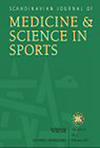田径大师级运动员的COVID - 19后病情:严重程度、症状以及与生活质量和C -反应蛋白水平的关系
IF 3.8
2区 医学
Q1 SPORT SCIENCES
引用次数: 0
摘要
在这里,我们评估了后COVID - condition (PCC,也称为长COVID)的患病率,并研究了其与田径大师运动员(MAs)健康相关生活质量和免疫相关生物标志物的关系。共216例男性114例,女性102例;年龄:58.3±11.9∶56.6±11.7岁;BMI: 23.6 [22.2-24.8] vs. 21.3 [20.0-23.6] kg/m2)通过COVID后综合征问卷(PCSQ)报告了他们的COVID后状况。在108名MAs亚组中,收集空腹血液样本以评估C反应蛋白(CRP)水平作为免疫状态(MAs - CRP)的生物标志物。根据患者PCSQ总分分为无/轻度、中度、重度3组。使用Fisher精确检验评估PCC严重程度与性别、运动特长和竞技水平之间的关系。46例(21%)MAs被确定为临床相关的中至重度COVID - 19后疾病(PCSQ评分>;10.75)。最常见的报告症状包括肌肉骨骼疼痛(15%)、睡眠障碍(13%)、感觉或呼吸症状(11%)、疲劳(11%)和流感样症状(11%)。PCC患病率在性别、运动专业、训练负荷或之前的比赛水平上没有差异(所有p >;0.05)。与无症状或轻度症状的患者相比,中度至重度PCC患者的生活质量生理和心理成分评分显著降低(p <;0.05)。在MAs - CRP亚组中,自我报告的心脏疾病和流感样症状与CRP水平显著正相关(Spearman ρ = 0.27-0.30,均p <;0.01)。COVID - 19后的状态与田径大师运动员的生活质量下降有关,与性别、先前的比赛水平和训练特征无关。此外,基于CRP水平的低度炎症与自我报告的心脏和流感样症状相关。本文章由计算机程序翻译,如有差异,请以英文原文为准。
Post‐COVID‐19 Condition in Track and Field Master Athletes: Severity, Symptoms, and Associations With Quality of Life and C‐Reactive Protein Levels
Here, we assessed the prevalence of post‐COVID‐condition (PCC, also known as long‐COVID) and investigated its associations with health‐related quality of life and immune‐related biomarkers in track and field masters athletes (MAs). A total of 216 MAs (114 males, 102 females; age: 58.3 ± 11.9 vs. 56.6 ± 11.7 years; BMI: 23.6 [22.2–24.8] vs. 21.3 [20.0–23.6] kg/m2 ) reported their post‐COVID‐conditions via the Post‐COVID Syndrome Questionnaire (PCSQ). In a subgroup of 108 MAs, fasting blood samples were collected to assess C‐reactive protein (CRP) levels as a biomarker of immune status (MAs‐CRP). Based on their PCSQ sum score, MAs were divided into three groups: no/mild, moderate, and severe. Associations between PCC severity and sex, athletic specialty, and competition level were evaluated using Fisher's exact test. Forty‐six (21%) MAs were identified with clinically relevant moderate‐to‐severe post‐COVID‐19 conditions (PCSQ score > 10.75). The most frequently reported symptoms included musculoskeletal pain (15%), sleep disturbance (13%), sensory or respiratory symptoms (11%), fatigue (11%), and flu‐like symptoms (11%). PCC prevalence did not differ by sex, athletic specialties, training load, or prior competition level (all p > 0.05). MAs with moderate‐to‐severe PCC had significantly lower physical and mental component scores of quality of life compared with those with no or mild symptoms (p < 0.05). In the MAs‐CRP subgroup, self‐reported cardiac ailments and flu‐like symptoms were significantly and positively associated with CRP levels (Spearman ρ = 0.27–0.30, all p < 0.01). Post‐COVID‐19 condition is associated with reduced quality of life in track and field masters athletes, independent of sex, prior competition levels, and training characteristics. Furthermore, low‐grade inflammation based on CRP levels was associated with self‐reported cardiac and flu‐like symptoms.
求助全文
通过发布文献求助,成功后即可免费获取论文全文。
去求助
来源期刊
CiteScore
7.90
自引率
4.90%
发文量
162
审稿时长
3 months
期刊介绍:
The Scandinavian Journal of Medicine & Science in Sports is a multidisciplinary journal published 12 times per year under the auspices of the Scandinavian Foundation of Medicine and Science in Sports.
It aims to publish high quality and impactful articles in the fields of orthopaedics, rehabilitation and sports medicine, exercise physiology and biochemistry, biomechanics and motor control, health and disease relating to sport, exercise and physical activity, as well as on the social and behavioural aspects of sport and exercise.

 求助内容:
求助内容: 应助结果提醒方式:
应助结果提醒方式:


